
Soon after I wrote about candying orange peel, people asked about candying other citrus. Clementines? Not enough pith. Grapefruit and pomelo? Very pithy. As I suggested in the original recipe for candied orange peel, if you’re going to tackle candied grapefruit peel, try the Ruby Red variety (aka Texas red or Rio Red grapefruit), which has a relatively thin peel. Admittedly, I’d never candied grapefruit peel before but the fact that people asked and then suddenly last week, Oroblanco (a hybrid of grapefruit and pomelo) appeared at our farmers’s market, I bought a few to try.
I adore Oroblanco for a refreshing Vietnamese salad so buying some to candy was not a difficult decision. I typically discard the peel and now, they had an experimental purpose! For a fun experiment, I bought one Ruby Red from the supermarket.
The result was surprisingly gorgeous and juicy, with a pleasant bittersweet flavor. The candied grapefruit and pomelo peels were softer than the candied orange peels. The peels were a little tricky to deal with so here are some tips.
Reducing Grapefruit Bitterness
Asian love to say that they endure life’s hardships well.In fact, chi ku (吃苦) in Mandarin literally translates to eating bitterness.When it comes to candying grapefruit or pomelo peel, which are naturally bitter, you can reduce the amount of bitterness simply by cutting some of the pith away. Take control of your bitterness whenever you can.
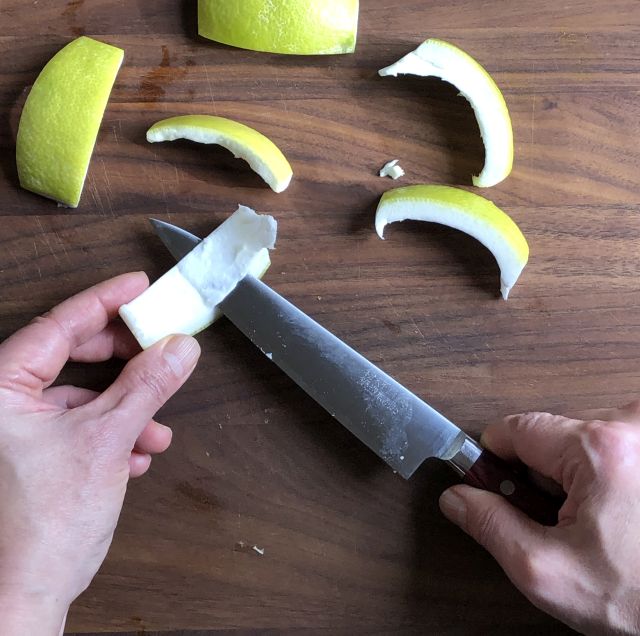
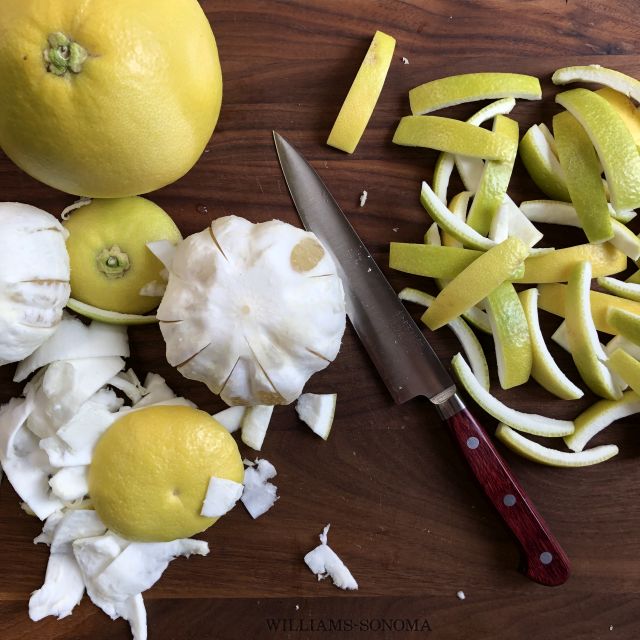
I used a very sharp petty knife (a Takamura R2, if you're curious), but you can use a paring knife, if you like. Like many pomelo, Oroblanco has lots of pith so I sawed some off with the knife so the peel was roughly ¼ inch thick.
The red grapefruit is more bitter (I chewed on some to see),and you can cut some of it off too. I did some but not others and there was a marginal difference in flavor difference among the candied grapefruit peel thicknesses.
After soaking in water, I parboiled the peel a little longer than for the orange peel in order to remove extra bitter flavor. I combined both kinds of citrus in the pot since they were roughly of the same length and thickness.
Glasslike Appearance
What was so wonderfully amazing was the glass-like appearance of the peels. Grapefruits and pomelos have softer, spongier pith than oranges so the pith soaked up the sugar syrup well, making the peels look like glass. The colors evoked ripe papaya flesh and chartreuse liqueur. Wow.
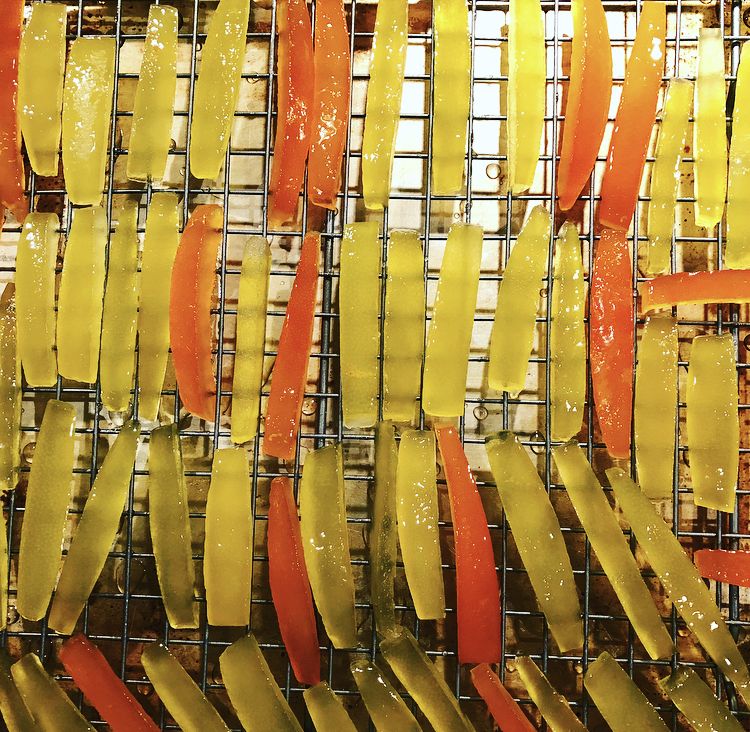
Despite being relative large and thick, the candied grapefruit and pomelo peel soaked up the sugar syrup in about the same amount of time as the orange peel, if not a little faster. They were so pretty drying on the rack but they had to be coated with sugar so they wouldn’t stick, plus the extra layer of sugar further reduces the peel’s natural zing.
Grapefruit vs. Pomelo Peel Flavor Difference
The candied Ruby Red grapefruit peel had a stronger, bitterness than the Oroblanco peel. The grapefruit peel’s flavor lingers on your palate fora while. That’s not a bad thing, especially if you eat a little chocolate on the side. You can also be fancy and dip one end of the grapefruit peel stick in melted dark chocolate.
By comparison, the candied Oroblanco peel is friendlier and less bitter. Getting Oroblanco isn’t easy because the season is short. Regular pomelo will work, too. Or, just stick with grapefruit! With citrus season in full gear, next time you make a Vietnamese pomelo salad, save the peel.
Related recipe
P.S. There were technical changes to the blogging platform so you'll be seeing little changes -- like the drop cap at the beginning of this post. I'm tinkering with a new recipe editing format so please be patient. Thank you!
Candied Grapefruit and Pomelo Peel
Ingredients
- 3 grapefruit or pomelo each about 5 inches wide
- 2 ½ cups plus about ⅓ cup sugar
- 1 ½ cups water
Instructions
- Use a sharp paring or petty knife to trim ½ inch from both ends of each grapefruit or pomelo. Reveal some flesh to make removing the peel easier. Then make cuts, from top to bottom and at 1-inch intervals, around each fruit. Make sure the knife goes through the peel and pith down to the flesh. Use your fingers to remove the peel in beautiful, discreet sections.
- If the pith is thicker than ¼ inch, wield the knife in a horizontal sawing motion to trim away excess pith from each section of peel. When done, cut each section lengthwise into ⅓ to ½-inch-wide strips.
- Put the peels into a saucepan and add enough water so that they float. Cover with a lid or plastic wrap and refrigerate overnight.
- Uncover and drain the peels. Return them to the saucepan and again add enough water so the peels float. Bring to a boil over medium heat, let boil for 1 good minute, and then drain. This mellows the harsh flavor of the peels.
- To candy the peels, use a wide, high-sided skillet (like a chicken fryer) that can accommodate them in a single layer. Put a wire rack on a baking sheet and place the baking sheet nearby for drying the finished strips. Put the 2 ½ cups sugar and all the water into the skillet. Bring to a boil over medium heat, stirring to dissolve the sugar. Add the peels, lower the heat to a simmer, and cook for 20 to 35 minutes, or until they look glassy and glazed. (If the peels are not all well exposed to sugar syrup, add a little extra sugar and water in a 5:3 ratio of sugar to water.)
- Occasionally stir the peels or swirl the pan to ensure even cooking, and lower the heat as needed to prevent scorching. During candying, the plump peels will shrink, straighten out, and soften. The white pith will turn practically clear. Use tongs to transfer each strip to the rack, placing them peel side up and not touching. Discard the sugar syrup or save for another purpose (add soda water for a spritzer, for example). Allow the peels to dry for about 1 hour, or until they feel tacky.
- To coat the peels, put the ⅓ cup sugar into a small bowl. Drop in a few strips at a time and shake the bowl back and forth to coat them well. Transfer to a plate and then repeat with the remaining peels. (If you run out of sugar, add more to the bowl.) When all the strips are coated, put them into an airtight container and store at room temperature for up to 7 days.
















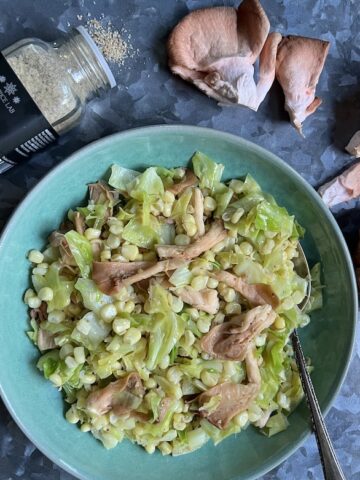
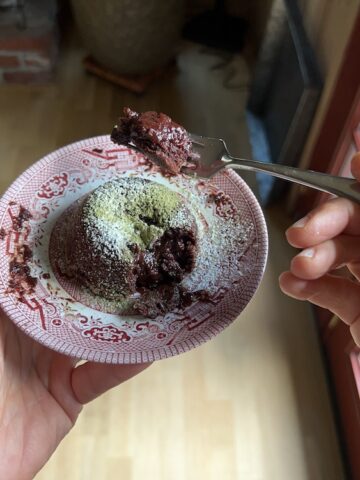
Y Lan Dao Tate says
One of my childhood favorites is Mứt Khoai, Candied Sweet Potatoes. Can you find me the recipe? I can’t find the right one on You Tube. I can’t buy ready made ones anywhere!
Andrea Nguyen says
I've not seen a recipe for that. Sorry. :-/